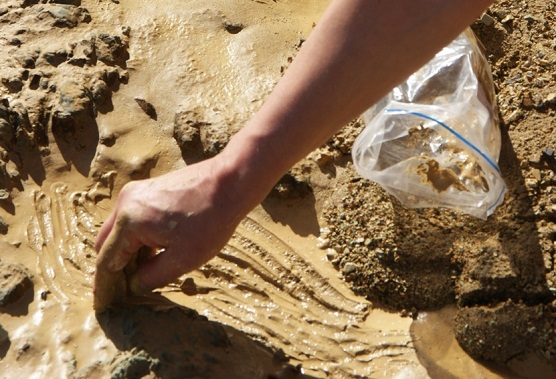Press release 2018-10-25 at 9:30

Photo: Pertti Mäkelä
Aalto University and Finnish Environment Institute press release
Working with Soil, an artistic research project at Aalto University's Department of Design, has been selected as one of the projects for Research Pavilion #3 in Venice. The University of the Arts Helsinki together with its international partners will create a research pavilion in connection with the Venice Biennale between May and August 2019.
Working with Soil will be implemented as a research laboratory that will focus on the issues related to the contamination of soil with the help of artistic methods. The research will utilise local soil that has become contaminated due to the actions taken by both industry and society as well as silt collected from the bottom of the sea. The project will be implemented in collaboration with the Finnish Environment Institute's contaminated land experts.
The work will be divided into three phases. In the first phase, the group of artists responsible for the exhibition will embark on two sample collection trips to the glass manufacturing area in Murano, the maritime industry area in Porto Marghera, and historic Venice. The hazardous materials contained in the samples will be analysed in a local laboratory.
Between May and June 2019, Research Pavilion #3 will contain an open laboratory where the public can follow the ceramic artists as they work with the collected local soil materials. The process will be capped off at an event in August where the artists will present the different phases and results of their work and the Finnish Environment Institute's expert will hold a lecture on the contamination of European soil.
“As artists and researchers, we want to literally get our hand dirty with this contaminated soil and highlight it as part of the artistic process and the works of art that we create. We hope that by visualising what is usually considered invisible, we can concretely present the effects that humans have on the environment,” explains the leader of the project, Aalto University Professor Maarit Mäkelä.
A significant problem in Europe
Land areas that have become contaminated due to long-term exposure to hazardous materials have become a significant environmental problem in Europe. An estimated 2.8 million areas in Europe are suspected or have been determined to contain contaminated soil. Surveying and repairing these areas is estimated to cost between 2.75−4.6 billion euros annually.
Hazardous materials enter the soil as a result of the neglectful or improper handling of chemicals and waste. The emissions by these materials usually originate from chemical accidents that have occurred years ago or from standard industrial activities. Landfills or waste from other locations can also contaminate soil. Thus, the reason can be traced back to the “old sins” related to common human activities.
The most usual contaminants found in soils are heavy metals, PHCs, PAH compounds and chlorinated solvents.
Research Pavilion #3
Appendices
Suspected number of contaminated land areas in EU member states
Event coordinated by the University of the Arts Helsinki
The programme of the University of the Arts Helsinki's research pavilion is structured around international research cells. The artists and researchers, almost 50 in total, who belong to the six research cells will participate in a nearly-year-long process where the research pavilion's themes and programme will grow and shape themselves through mutual discussion and dialogue. The Working with Soil project is one of the participants and is implemented in collaboration with the University of the Arts Helsinki's Insects Among Us project, as part of the Traces from the Anthropocene theme. Another artistic research project from Aalto University, Artistic Intelligence Research Alternator (AIRA), will also participate in the research pavilion in collaboration with the University of the Arts Helsinki's Disruptive Processes project. The AIRA project includes Susanna Helke, Liisa Ikonen, Marko Karo, Harri Laakso and Maiju Loukola.
Further information
Professor Maarit Mäkelä, Aalto University, tel. +358 50 372 2168, maarit.makela@aalto.fi
Special Researcher Jussi Reinikainen, Finnish Environment Institute SYKE, tel. +358 29 525 1551, jussi.reinikainen@ymparisto.fi